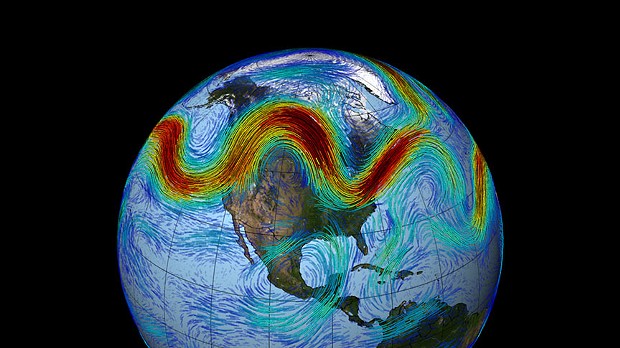[
{
"name": "Top Stories Video Pair",
"insertPoint": "7",
"component": "17087298",
"parentWrapperClass": "fdn-ads-inline-content-block",
"requiredCountToDisplay": "1"
}
]
Although the recent winter storms helped replenish California's dangerously low reservoirs and cropland water tables, much (much!) more rainfall is needed to get the Golden State back to normal. However, what was "normal" pre-2000 is now history, and we may have to reset our expectations. Our future climate is more likely to be like that of the last 15 years, or even the last three years: Based on tree-ring data, the years 2012 through 2014 were the state's hottest and driest since 800 AD, according to a recent report published by the American Geophysical Union.
New patterns in the jet stream appear to be the culprit. What's usually called the jet stream here in the U.S. is the "northern hemisphere polar jet" (there's a less important jet closer to the equator, with mirror images of both jets in the southern hemisphere). Think of it as a thick and wide eastward-flowing wavy river of wind, between 5 and 8 miles high, dividing cold polar air from warm equatorial air. An upward kink in the jet allows high-pressure, causing warm air to flow north; where it bulges down, cold wet air courses south as a low-pressure trough.
Before about 2000, those upward and downward kinks were gentle, and took only about four days to move across the U.S. from the west to the east coast. Since then, the kinks have both deepened and slowed, stalling for weeks at time. On the west coast, we experience the resulting extreme weather as long periods of dry, hot, high-pressure systems, while east coast residents suffer as low pressure zones bring multiple wet and cold polar vortices.
Causes of climate change are notoriously hard to pin down, hence the extreme claims by politicos of all stripes. Our planet is warming — no one argues that — with the main cause being the 5-percent-per-decade increase in heat-trapping carbon dioxide in the atmosphere ("Global Warming?" March 24, 2011). The temperature isn't rising uniformly, however: The Arctic is warming about three times faster than the rest of the Northern Hemisphere, leading to unprecedented summer sea-ice melting: a 50-percent increase in the last 15 years. Ice reflects the sun's rays, but when it melts, dark water absorbs much of that sunlight. This leads to atmospheric warming in the Arctic and thus less of a difference between the temperatures of arctic air and equatorial air.
Many climatologists now believe that the reduced temperature difference is causing the current behavior of the jet stream. (Some researchers focus more on changes in El Niño and La Niña, also attributable to increased CO2 levels). With less of a temperature difference between its northern and southern boundaries, the stream slows down and forms deep bulges. If this theory is borne out, we can expect ever-more extreme weather as the Arctic summer sea ice thins out and eventually disappears (probably by 2030), leading to wild gyrations in the jet stream.
Our changing climate is having global political effects. Several research papers link the 2011 Arab Spring uprisings in the Middle East to the extreme 2010 drought in Asia: With virtually no grain exports from Russia, wheat prices rose and popular unrest followed. Here in drought-stricken California, our unrest at this point is mostly limited to the rights of Klamath salmon versus Central Valley farmers. I suspect we've only just begun to see the ramifications of our new climate.
Barry Evans ([email protected]) finds it ironic that, now that we can actually do something about the weather, we're doing all the wrong things.
more from the author
-
The Myth of the Lone Genius
- Jun 6, 2024
-
mRNA Vaccines vs. the Pandemic
- May 23, 2024
-
Doubting Shakespeare, Part 3: Whodunnit?
- May 9, 2024
- More »


































